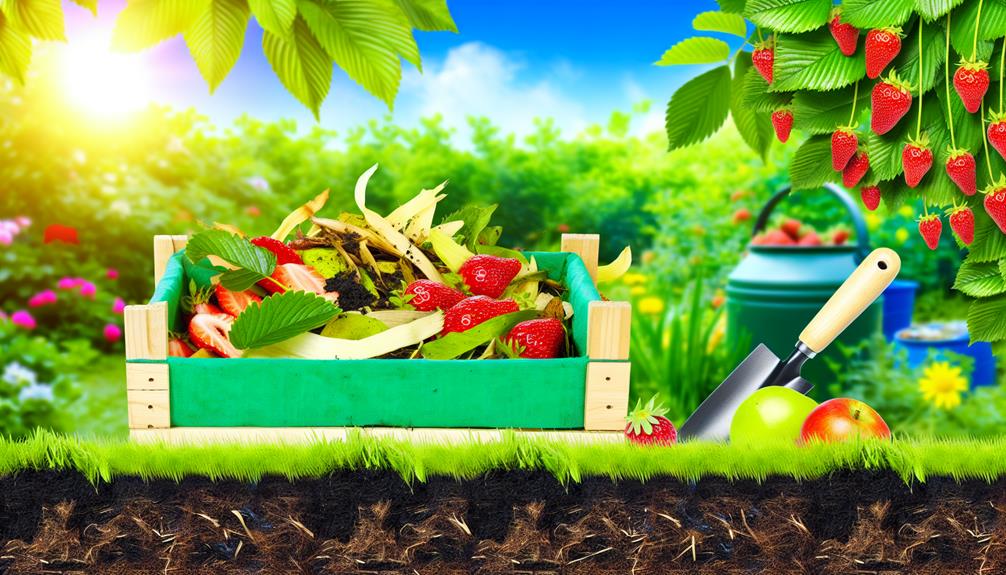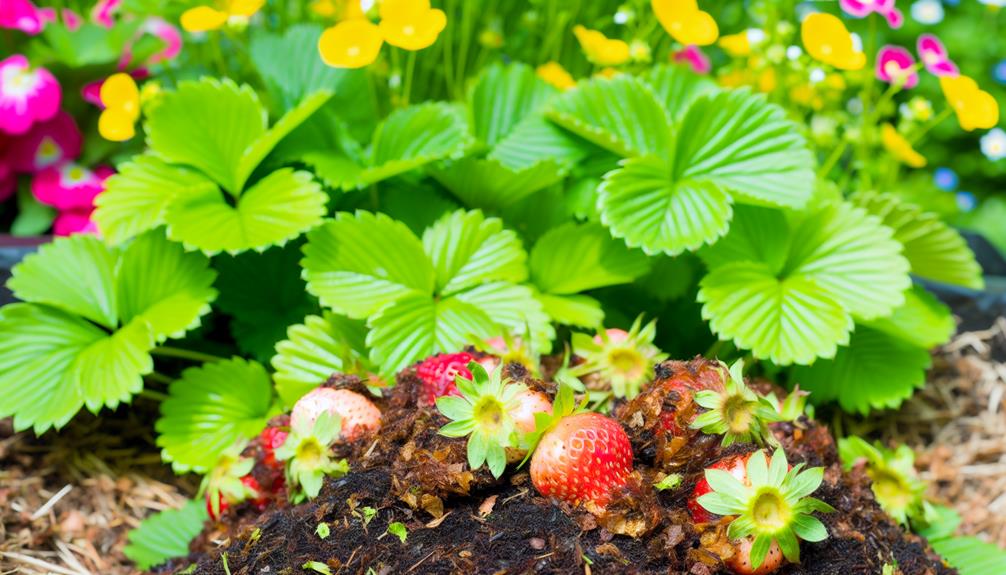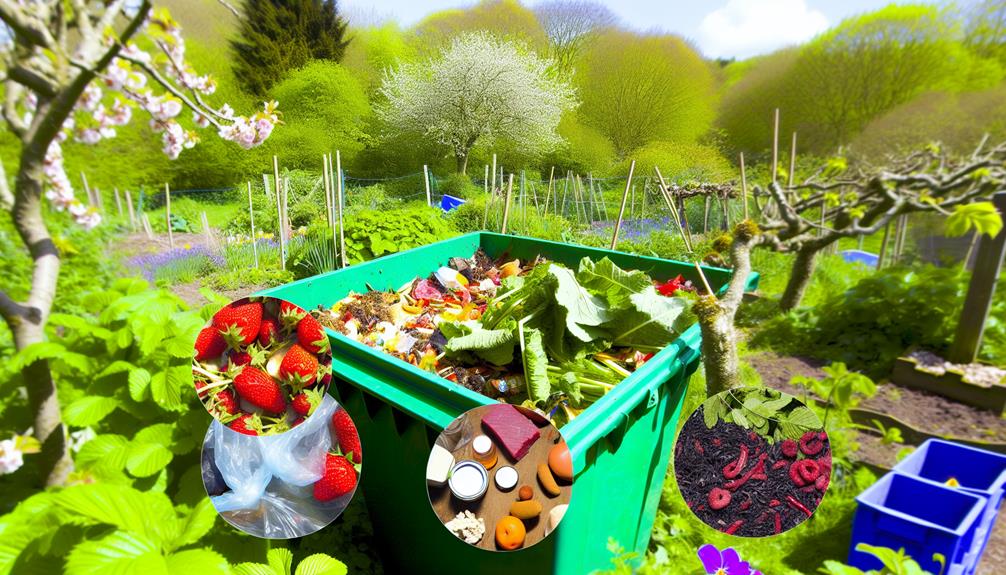

You can absolutely compost strawberries. They enrich your compost with valuable nutrients and help maintain proper moisture levels. To maximize their benefits, balance them with carbon-rich materials like dry leaves or straw. It’s important to bury any moldy strawberries deep in the pile to manage mold growth.
Always turn your compost regularly to guarantee even decomposition and proper aeration. By combining strawberries with a mix of green and brown materials, you create a healthier compost environment. Be mindful of moisture; aim for a texture similar to a wrung-out sponge. For further tips on perfecting your compost, stay engaged.
Composting strawberries not only reduces waste but also enriches your soil with valuable nutrients. When you compost these sweet fruits, you’re helping the environment by decreasing the amount of organic waste that ends up in landfills. This simple action cuts down on methane emissions, a significant greenhouse gas, thereby minimizing your environmental impact.
You’re also promoting waste reduction in your home garden. Instead of tossing strawberry scraps into the trash, you can turn them into rich, fertile compost. This compost can be used to nourish your plants, providing them with essential nutrients like nitrogen, phosphorus, and potassium. These nutrients are vital for plant growth, leading to healthier and more vibrant gardens.
To get started, just add your strawberry scraps to your compost pile or bin. Mix them with other compostable materials like leaves, grass clippings, and kitchen scraps. Make sure to turn your compost regularly to speed up the decomposition process.
When adding fresh strawberries to your compost, you’ll boost the nutrient content substantially.
It’s important to manage their moisture levels by balancing them with dry materials like leaves or straw.
This balance guarantees your compost remains healthy and effective.
Adding fresh strawberries to your compost can significantly enhance its nutrient content. These vibrant red fruits are packed with essential nutrients like nitrogen, potassium, and phosphorus. When you toss them into your compost pile, they break down and release these nutrients, enriching the compost and making it a potent fertilizer for your garden.
One immediate benefit you’ll notice is an improvement in compost texture. Strawberries are soft and break down quickly, helping to balance the mixture of green and brown materials. This results in a more crumbly, well-structured compost that’s easier to spread and mix into your soil.
Moreover, strawberries boost microbial activity. Their sugar content provides an energy source for the microorganisms in your compost, speeding up the decomposition process. This increased microbial activity ensures that your compost matures faster and becomes more effective at nourishing your plants.
To get the best results, cut the strawberries into smaller pieces before adding them to your compost. This helps them break down even quicker. Remember to mix them thoroughly with other compost materials to maintain a balanced pile.
Your garden will thank you for the nutrient-rich boost!
Maintaining the appropriate moisture levels is essential when you incorporate fresh strawberries into your compost. Strawberries have high water content, which can affect the balance of your compost pile. To manage this, you should focus on moisture absorption and water retention strategies.
First, make sure you’re mixing strawberries with dry materials like leaves, straw, or cardboard. This prevents your compost from becoming too wet. Aim for a balance where the compost feels like a damp sponge.
Here’s a quick guide to help you balance moisture levels:
| Material | Moisture Content | Purpose |
|---|---|---|
| Fresh Strawberries | High | Adds moisture and nutrients |
| Dry Leaves | Low | Absorbs excess moisture |
| Straw | Low | Enhances aeration |
| Cardboard | Low | Improves moisture absorption |
Using these materials together helps maintain an ideal environment for decomposition. Turn your compost regularly to ensure even distribution of moisture and aeration.
Also Read: Can You Compost Cabbage?
Don’t hesitate to compost moldy strawberries, but make sure you handle them properly to prevent spreading mold to other compost materials. First, learn moldy identification: look for fuzzy white or green spots on the berries.

Once you’ve identified moldy strawberries, it’s important to choose proper disposal methods. Instead of tossing them directly into your compost bin, consider using a separate container for moldy materials to isolate them.
When you’re ready to add them to your compost, bury the moldy strawberries deep within the pile. This helps guarantee that mold spores don’t spread easily to other compostable items, maintaining the overall health of your compost.
Turning your compost pile regularly will also help manage mold growth by promoting aeration and decomposition.
Incorporating overripe strawberries into your compost heap can enrich it with valuable nutrients, accelerating the decomposition process.
Make sure to bury the strawberries under other compost materials to prevent pests from being attracted.
Overripe strawberries can be a valuable addition to your compost pile, enriching it with essential nutrients. When you incorporate these fruits into your compost, you’re contributing to soil enrichment by adding organic waste that’s rich in vitamins and minerals. Strawberries break down relatively quickly, releasing nutrients that benefit your garden soil in the long run.
First, make sure to cut the strawberries into smaller pieces. This increases their surface area, helping them decompose faster. Mixing them evenly with other compost materials is important. Balance the strawberries with carbon-rich materials like dried leaves or paper to maintain a healthy compost ratio.
Don’t worry about the seeds in the strawberries; they won’t sprout in the compost pile. Instead, they’ll break down along with the fruit, ensuring that your compost remains a nutrient-rich addition to your garden.
It’s important to turn your compost regularly, which helps aerate the pile and speeds up decomposition.
To expedite the decomposition process, make sure you properly prepare and balance the strawberries with other compost materials. Chop or mash the overripe strawberries before adding them to your compost pile. This breaks them down into smaller pieces, accelerating their decomposition.
Next, balance the strawberries with a mix of green and brown materials. Greens include fruit scraps, vegetable peels, and coffee grounds, while browns consist of dry leaves, paper, and cardboard. A good ratio is three parts brown to one part green.
Turning frequency is essential. Regularly turning your compost aerates it, providing oxygen necessary for microbial activity. Aim to turn your pile at least once a week. This keeps the compost well-mixed and ensures even decomposition.
Temperature control is another key factor. Optimal composting occurs between 135°F and 160°F. Use a compost thermometer to monitor the temperature, adjusting your pile if it gets too hot or too cold. If temperatures drop, add more green materials and turn more frequently to boost microbial activity.
Keeping pests at bay is crucial when adding overripe strawberries to your compost pile. You want to avoid attracting unwanted critters. Start by using barrier methods. Cover your compost pile with a layer of leaves or straw. This creates a thorough barrier that deters pests from getting to the strawberries.
Next, consider natural repellents. Sprinkle some coffee grounds or citrus peels around the perimeter of your compost. Both are excellent at keeping pests away. Additionally, you can use a compost bin with a secure lid to further prevent access.
Here’s a quick comparison of barrier methods and natural repellents:
| Method | Example | Effectiveness |
|---|---|---|
| Barrier Method | Leaves | High |
| Barrier Method | Straw | High |
| Natural Repellent | Coffee Grounds | Medium to High |
| Natural Repellent | Citrus Peels | Medium to High |
Use these strategies together for the best results. By combining them, you create a complete pest prevention plan. Remember, a well-maintained compost pile not only keeps pests away but also breaks down your organic materials more efficiently. So, keep your compost covered and use natural repellents to ensure a healthy, pest-free composting environment.
Also Read: Can You Compost Wood Scraps?
Achieving a balanced compost pile means combining green and brown materials in the right proportions. You need to understand the C:N ratio, which stands for the carbon-to-nitrogen ratio. Green materials like strawberry scraps, grass clippings, and vegetable peels provide nitrogen. Brown materials, such as dried leaves, straw, and cardboard, offer carbon. The ideal compost balance is a C:N ratio of about 30:1.
To maintain this balance, layer your green and brown materials. Start with a base of brown materials to guarantee good aeration. Add a layer of green materials, followed by another layer of browns. Repeat this process, making sure that each layer is about 2-4 inches thick.
Mix your pile regularly to distribute the materials evenly and promote aeration. This helps the microorganisms break down the organic matter efficiently.
If your compost pile is too wet or smelly, add more brown materials. If it’s too dry and slow to decompose, mix in more greens.
While maintaining a balanced compost pile, it’s also important to prevent pests and odors. A well-managed compost bin not only produces rich, fertile compost but also keeps your garden area pleasant.
To achieve this, you’ll need to follow a few essential tips.
First, always cover food scraps with a layer of dry leaves, straw, or shredded newspaper. This helps mask odors that attract pests.
When adding strawberries to your outdoor compost, make sure they’re buried well within the pile. This reduces the likelihood of pests such as rodents or insects drawn to the sweet smell.
It’s also vital to manage the moisture level. A compost pile should be as damp as a wrung-out sponge. Too much moisture can lead to unpleasant odors, while too little can slow down decomposition.
Turn your compost regularly to guarantee proper aeration, which helps control both moisture and odor.
Incorporating strawberries into your compost pile works best when you mix them with a variety of other compost materials. This approach, known as compost layering, guarantees you achieve the right balance of greens and browns, which is crucial for effective decomposition. Greens, like your strawberry scraps, provide nitrogen, while browns, like dried leaves and cardboard, offer carbon. For a healthy compost pile, you need both elements working together.
To help you visualize the balance of materials, here’s a simple table:
| Greens (Nitrogen) | Browns (Carbon) |
|---|---|
| Strawberries | Dried Leaves |
| Vegetable Peels | Cardboard |
| Coffee Grounds | Wood Chips |
To expedite the decomposition process, you should focus on maintaining ideal moisture levels and ensuring good aeration throughout your compost pile. Both aspects are essential for fostering effective microbial activity, which is the engine behind decomposition.
First, keep your compost pile as damp as a wrung-out sponge. Too dry, and microbial activity slows down; too wet, and it can become anaerobic, leading to unpleasant odors. Regularly check moisture levels and adjust by adding water or dry materials as necessary.
Next, incorporate effective aeration techniques to boost oxygen flow. Turning your pile with a pitchfork every one to two weeks helps introduce fresh air, promoting aerobic conditions that microbes thrive in. Additionally, layering your compost with coarse materials like straw or small branches can create air pockets and enhance overall airflow.
Also Read: Can You Compost Butter?
One common mistake in composting is adding meat or dairy products, which can attract pests and create foul odors. Instead, focus on plant-based materials like fruit peels, vegetable scraps, and coffee grounds.

Another issue you might encounter is improper layering. It’s crucial to alternate between green materials (nitrogen-rich) like kitchen scraps and brown materials (carbon-rich) like dried leaves. A good rule of thumb is to maintain a ratio of three parts brown to one part green. This balance helps in maintaining the right conditions for decomposition.
Excess moisture is another pitfall. While compost needs to be damp, it shouldn’t be soggy. Too much water can lead to anaerobic conditions, slowing down the composting process and causing odors. To prevent this, make sure your compost pile has proper drainage and turn it regularly to aerate the materials.
Lastly, avoid adding large chunks of material without chopping them first. Smaller pieces decompose faster, ensuring a quicker turnaround for your compost.
Yes, you can compost strawberry leaves and stems. They break down well and don’t attract strawberry pests. Plus, they help create rich leaf mold, which benefits your garden and makes you part of an eco-friendly community.
Yes, you should wash strawberries before composting them. Washing removes pesticide residue and reduces the risk of mold growth. Taking this step guarantees a healthier compost pile, contributing to a cleaner, more welcoming garden environment for everyone.
Strawberries have moderate nitrogen content, which is great for your compost. However, they have a higher carbon ratio. So, when you add them, balance it out with more green materials to maintain a healthy compost mix.
You can compost strawberries in a small indoor compost bin. Their fruit decomposition provides valuable nutrients for your compost. Just make sure to balance with browns to maintain a healthy composting indoors environment for your community.
You’ll find that strawberries decompose fairly quickly in compost, typically within a few weeks. Their decomposition rate depends on microbial activity, which thrives in a well-maintained compost bin. You’ll see results faster with consistent care.
Incorporating strawberries into your compost pile is highly beneficial. Whether they’re fresh, moldy, or overripe, strawberries add valuable nutrients to your compost.
Remember to balance your pile with other compost materials to prevent pests and odors. Regularly mixing and monitoring the pile will speed up decomposition.
Avoid common mistakes like adding too many strawberries at once. Following these tips guarantees a healthy, efficient composting process that enriches your garden soil.
